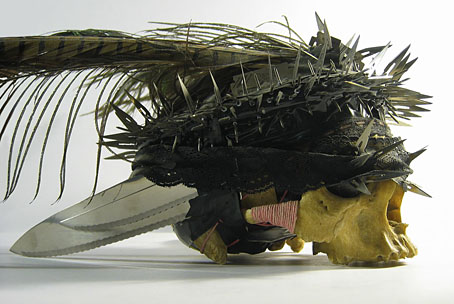Mention yesterday of pencil drawing prompted me to dig out this item from one of my old portfolios. It was drawn shortly after I was given a somewhat battered human skull by a student nurse (hello, Victoria, wherever you are), an object I sketched on a number of occasions before eventually making it into the finger-slashing fetish object below which appeared recently in the The Thackery T. Lambshead Cabinet of Curiosities. The drawing dates from 1983—I remember listening to the Art of Noise EP Into Battle whilst working—and it’s unusual for me in showing the drawn object alone on a sheet of paper with no attempt made to place it in a scene. It’s also a slightly misjudged rendering; this ink drawing from a year later shows a more careful representation of the skull’s proportions, spoiled a little by the pointless and unconvincing seascape I placed behind it.
9 thoughts on “Skull, 1983”
Comments are closed.



I wonder if it’s still so easy to give your friend an anonymous skull if you’re a student nurse these days?
You weren’t ever tempted to turn it into a cup like Lord Byron?
http://www.nicks.com.au/index.aspx?link_id=76.690
She said they had a room full of spare bones that were used for teaching purposes. The skull was rather grubby and marked in places with Biro. It had also lost most of its teeth and one of the latches that stop the cranium lid from falling off. And there was no jaw, of course. You can always spot ex-medical skulls in films (as in Monty Python and the Holy Grail) since they usually have bisected craniums.
Byron’s cup is a little like the things Tibetans make (or used to make) from skulls. Skull drums are common. Alan Moore has one of those weird and somewhat scary Tibetan skulls embellished with silver. Not the kind of thing everyone would want in the house.
Do you keep the finger-slashing fetish object that you’ve turned it into in a prominent location to scare off unwanted intruders or does it make a good conversation piece for any visitors you might have at home?
“That’s just the trophy skull I made from the last person who upset me”
Re Python.
Recent News: http://www.comedy.co.uk/features/graham_chapman_blue_plaque/
http://www.digitalspy.com/celebrity/news/a404336/monty-pythons-graham-chapman-gets-unofficial-blue-plaque.html
This one is a bit weird http://openplaques.org/plaques/2921
Reminds me of “Which one’s Pink?” on the Floyd’s Have a Cigar. In this case it would be Which one’s Monty?
Blue plaques just remind me of the Fake Doco from the Python Night back in 1999
Pythonland, plays on Michael Palin’s more recent travel series (Around the World in 80 Days, Full Circle), while documenting location sites of some of MPFC’s most popular sketches. Actually well done, this piece overlays contemporary shots with the original filmed versions, with Palin imparting tidbits of production history as he goes. Spots include the quay at Teddington Lock (Fish-Slapping Dance); Thorpebank Road (New Cooker Sketch and The Ministry of Silly Walks) and Ealing, a borough much (ab)used by the boys (Climbing the Uxbridge Road, Hell’s Grannies). Often he would knock on the door of some unsuspecting person (who of course immediately recognized the famous Palin from his many travel series), tell them about the “historic” importance of their particular door or house, and then put up an official looking blue plaque saying something like “Monty Python’s Silly Walk sketch filmed here 1971.” Not surprisingly, many of the locations were within spitting distance of the BBC Television Centre in West London. It ends at the beginning, with Palin wading out into Poole Harbour, Dorset, from the exact spot of his “It’s” man’s emergence, 30 years ago.
The fetish skull is in a corner on a bookshelf in front of a framed photo of the baby from Eraserhead. Most visitors are usually too overwhelmed by the shelves of books and CDs to pay much attention to ornaments.
I suppose the plaque for Monty Python singular is a means of saving space. Crowding all those names together might make for something that wasn’t very legible.
Are your bookshelves as overwhelming as Neil Gaiman’s?
http://blog.shelfari.com/my_weblog/2009/09/neil.html
you might like this …
Grahman sans python
http://www.youtube.com/watch?v=nwOcc-buSsg&feature=relmfu
No, I don’t have rooms large enough to accommodate that quantity of shelving.
Good find with the Graham Chapman piece, that’s the one I told you I remembered seeing. Was only ever shown once so it’s good to know it’s been preserved.